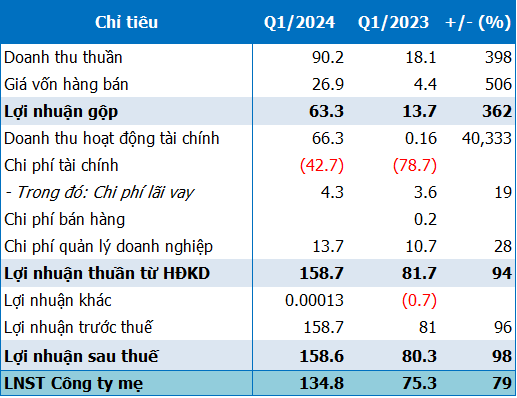
From the beginning of 2024, the State Bank of Vietnam (SBV) has vigorously implemented the government’s directive on prioritizing growth coupled with macroeconomic stability and inflation control as stated in Resolution 01/NQ-CP and other directive documents, implementing measures to manage credit operations, remove difficulties, and enhance credit accessibility. Accordingly, SBV has implemented a comprehensive set of solutions to facilitate credit supply by credit institutions, as well as create favorable conditions for individuals and businesses to access credit. Specifically:
SBV has formulated Directives 01 and 02/CT-NHNN, Action Program 83/QD-NHNN to implement the government’s directive on the annual banking activities focus in 2024. The goals, tasks, and specific operating solutions for the entire system, especially credit operations, have been established to ensure capital supply for the economy, support individuals and businesses in accessing credit for production, business activities, consumption, and legitimate living needs, contributing to promoting economic growth, controlling inflation, maintaining macroeconomic stability, and ensuring the safe operation of credit institutions.
SBV has continued to review and improve legal regulations in credit activities to facilitate the operations of credit institutions, enhance access to banking credit, and support customers facing difficulties in credit activities. These include: Improving and submitting to the National Assembly for passage of the Credit Institution Law (amended) during the extraordinary session in January 2024; reviewing and evaluating to amend and supplement Circular 06/2023/TT-NHNN on lending activities of credit institutions, Circular 16/2021/TT-NHNN on the purchase and sale of corporate bonds by credit institutions; evaluating to consider amending Circular 02/2023/TT-NHNN on debt repayment schedule restructuring while maintaining debt groups, with an extended timeline to implement policies; reviewing to amend, supplement legal corridors, improve the operations of financial companies, financial leasing companies, microfinance organizations, etc., to stimulate credit demand and increase the official credit supply for legitimate living and consumption needs, contributing to limiting “black credit”.
In addition, SBV has actively managed credit growth to supply capital and support economic growth. In 2024, based on the target of achieving economic growth of around 6-6.5% and inflation of about 4-4.5% set by the National Assembly and the Government, SBV has aimed for a credit growth rate of about 15% for the entire system, adjusting appropriately according to the situation, actual conditions. By December 31, 2023, SBV has allocated all credit growth targets for 2024 to credit institutions, publicly announced the principles for determining so that credit institutions can proactively implement credit growth to provide credit capital for the economy.
On February 7, 2024, SBV continued to issue Official Letter 1088/NHNN-CSTT directing credit institutions to intensify the implementation of solutions set out in Directive 01/CT-NHNN dated January 15, 2024, aiming to promote economic growth. These include aggressively implementing credit growth solutions right from the beginning of the year, strengthening review and simplification of credit approval procedures, optimizing digital transformation in the credit approval process, creating favorable conditions for access to bank credit, etc.
Parallel to that, SBV continues to manage interest rates to ease difficulties for the economy. In early 2024, SBV has maintained the current levels of policy rates to provide credit institutions with easy access to low-cost capital from SBV, contributing to supporting the economy. As of January 31, 2024, the deposit and lending interest rate levels continue to decrease; the average deposit and lending interest rates for new transactions of credit institutions have decreased by about 0.15% per year and 0.25% per year respectively compared to the end of 2023. SBV has also issued Official Letter 117/NHNN-CSTT on February 7, 2024, requesting credit institutions to continue implementing the directions of the Prime Minister and SBV regarding interest rates and reporting the situation of announced average lending rates, deposit-lending interest rate spreads.
In addition, SBV continues to vigorously implement credit programs, policies, solutions for priority sectors and growth drivers, essential industries and commodities of the economy; removing difficulties, enhancing credit accessibility. SBV is also proactively implementing the tasks of the banking sector in national target programs; supporting and creating favorable conditions for social policy banks to implement preferential credit programs for the poor households and other policy beneficiaries…
Orientation and operating solutions for credit operations in 2024
In 2024, the world economy is expected to continue facing difficulties due to tighter financial conditions, geopolitical conflicts, increasing financial risks, global inflation is projected to continue a slowing trend but still higher than target in many countries amidst the risks of energy, food, agricultural crises due to the strategic competition between major countries…; domestic economic growth continues to face challenges as global demand is expected to remain low, world economic growth in 2024 is forecasted to be lower than 2023 by many international organizations, impacting trade, investment activities, and the manufacturing industries…
In this context, SBV continues to identify focal tasks and solutions for credit operations in 2024, specifically as follows:
(i) Managing the credit growth of the entire system of credit institutions in 2024 at about 15%, adjusting appropriately according to the situation, actual conditions; researching, innovating credit growth management work. Implementing proactive, flexible, and appropriate credit management measures in line with macroeconomic developments and inflation to meet capital needs for the economy.
(ii) Managing interest rates in line with market trends, macroeconomic conditions, inflation, and SBV’s targets; encouraging credit institutions to reduce costs, streamline credit approval procedures, enhance technology application and digital transformation in the credit approval process, striving to reduce lending interest rates to support the economy.
(iii) Directing credit institutions: Promoting safe and effective credit growth, focusing credit on the areas of production, prioritized sectors, and growth drivers; continuing to tighten credit in potential risk areas; reviewing, simplifying loan application procedures, collateral requirements, creating favorable conditions for businesses and individuals to access bank credit; expanding credit to serve production, business activities, and serve legitimate consumption and living needs, contributing to limiting “black credit”.
(iv) Continuing to instruct credit institutions to actively implement national credit programs, policies, as directed by the Government and the Prime Minister, including the 120-trillion-dong credit program for social housing development, workers’ housing, renovation and construction of old condominiums, the program of financing the production, processing, and consumption of high quality and low emission rice products in the Mekong Delta. Cooperating with ministries and sectors to promptly resolve obstacles in the implementation process.
(v) Regularly organizing business connection conferences, the enterprise association in suitable forms by region and in all provinces and cities. Directing credit institutions to concurrently organize customer conferences to resolve difficulties and share challenges with customers.
(vi) Continuing to promote the implementation of assigned tasks of the banking sector in national target programs.











































